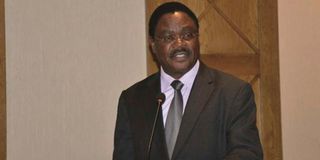Covid, end of Module II hit varsity coffers hard

University Education Principal Secretary Simon Nabukwesi
Diminishing funding from the government, the high cost of management, collapse of the self-sponsored student programme and the pandemic are among the reasons universities are broke.
Nairobi, Kenyatta, Egerton, Jomo Kenyatta, Rongo, Maseno, Cooperative, Multimedia, Kisii,Maasai Mara and Moi are among the universities with high monthly deficits.
Due to low government funding, universities cannot pay statutory deductions while some have had to reduce their workers.
According to a report on public universities that is before the National Assembly Education Committee, universities statutory deduction arrears stood at Sh37.3 billion by September 2020. The deductions include NHIF, NSSF and taxes.
For years, the universities heavily depended on the parallel degree programme to get money.
Since the government allowed anybody who scores C+ and above in the Kenya Certificate of Secondary Education examination to join university, the institutions have struggled to get money.
Vice-chancellors and the Ministry of Education are in the process of finalising university reforms. The government sets aside approximately Sh97 billion for public universities every year.
Covid-19 pandemic
The pandemic has also led to the shutting of universities and their constituent colleges. There is also the problem of failure by students to pay fees.
During the graduation ceremony at Jomo Kenyatta University of Agriculture and Technology, University Education and Research PS Simon Nabukwesi urged institutions of higher learning to generate money through inter-disciplinary research.
The PS said despite the commitment of the government to fund the institutions, the adverse effects of the Covid-19 pandemic have compelled the National Treasury to adjust spending.
“While the government has remained steadfast in funding universities, this has lately been complicated by the Covid-19 pandemic. The net result is that the funding may not be sustainable in the long run,” Mr Nabukwesi said.
He admitted that public universities face financial problems but added that the Ministry of Education is exploring possible solutions.
The universities also have huge pending bills.
Vice-chancellors have asked the government to start funding diploma students sent to the institutions by the Kenya Universities and Colleges Central Placement Service (KUCCPS).
The government only funds diploma students in technical and vocational training institutions.
Private institutions
National Association of Private Universities in Kenya chairman Simon Gicharu said the number of people seeking admission to the institutions has drastically gone down.
“The Covid-19 pandemic effects are being felt by universities too,” he said.
He added that since the government started sponsoring students who score C+ and above in KCSE test for university courses, the financial situation of private institutions has been badly hit.
“The situation is better for private universities that receive government-sponsored students,” Mr Gicharu, who is also the chairman of Mt Kenya University, said.
The government began sponsoring students in private universities in 2016.
Some 6,312 government-sponsored students were admitted to private institutions in the 2016/17 academic year.
In the 2017/18, the number increased to 18,587, rising to 29,826 in the 2018/19, while 40,102 were enrolled in the last academic year. It grew to 61,237 in the 2020/21 academic calendar.
In 2020, Mt Kenya University was allocated 4,400 students, Kabarak (2,327), Kenya Methodist (2,268,) Catholic University of Eastern Africa (2,091) while KCA University received 2,062 students.





